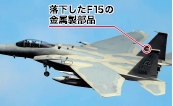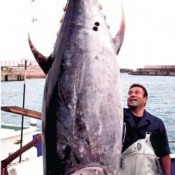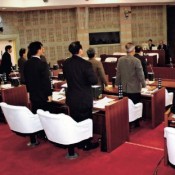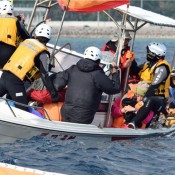
February 6, 2015 Ryukyu Shimpo
An F-15 fighter belonging to U.S. Air Force Kadena Air Base lost its distal portion weighing 5.4 kg from the left of the vertical stabilizers during flight on February 4. This conical shaped metal part is about 23 cm high and about 15 cm in width. According to the Okinawa Defense Bureau, which has received information from officials of the Kadena Base, there is a possibility that the parts fell into the sea. No damage or injuries were reported. There were five similar accidents where parts fell from F-15s last year. However, the air force has not taken measures such as suspending flights.
On January 15, parts, including missile launchers weighing 208 kg fell from an AH-1W attack helicopter belonging to U.S. Marine Corp Air Station Futenma. On January 23, An HH-60 helicopter based at the Kadena Air Base lost parts weighing 68 grams. Such incidents involving parts falling from U.S. aircraft have taken place frequently since the beginning of this year.
According to the defense bureau, maintenance crews noticed that the parts were missing when the F-15 returned to the base on February 4. The defense bureau received information from officials at the Kadena Base at 10:20 a.m. on February 5. Then, it notified the Okinawa Prefectural Government and relevant municipalities about the incident.
An official from the Okinawa Prefectural Government said, “it could lead to a serious accident if the pilot makes one wrong move. Despite requests to prevent a recurrence of incidents, it is very regrettable that cases involving parts falling from aircraft take place one after another.” The Okinawa Prefectural Government sought assurances from the Kadena Base officials that they would prevent a recurrence of accidents and take safety precautions.
(English translation by T&CT)
Go to Japanese

February 1, 2015 Ryukyu Shimpo
At Urasoe City Tedako Hall on January 25, the Urasoe City Education Board held a symposium to trace the roots of karate. Many experts of Chinese martial arts and karate took the podium. They announced research results on the history, relationship, and similarities between karate and Chinese martial arts.
Using special subsidies from Okinawa promotion funding, the city held the symposium as part of a project to trace the roots of Ryukyuan karate. The research was carried out from the fiscal year 2012 to 2014.For this project, research and examination committee meetings were held several times every year. They sent a team to China to investigate into Chinese martial arts. The city plans to publish a research report on the project in March.
At the symposium, Chinese martial arts and karate demonstrations were performed. In his keynote lecture, Zhou Kunmin, the chairman of the International Southern Shaolin Ngo Cho Kun Fraternal Association, said, “Ryuykuan martial arts such as Suidii, Tumai-dii, and Naafa-dii are surprisingly similar to Quanzhou Southern Shaolin Kun.” He explained that the originators of traditional Okinawan styles of karate Gojuryu and Uechiryu studied martial arts that descended from Southern Shaolin Kun.
Tokumasa Miyagi, former president of the Okinawa Prefectural University of Arts, introduced many documents on Chinese martial arts and karate. Masayuki Dana, a professor at Okinawa International University, said there is a description of karate in the documents such as the Notes of Oshima, An Account of A journey to Satsuma, and Southern Island Chitchat. Dana continued, “Ryukyuan martial artists learned kata from Chinese envoys Sapposhi. They created the original karate kata from the modern to contemporary period.
Weng Xinhui of Physical Education College of Jimei University, Kiyoshi Tsuha, president of Urasoe City Karate Do Confederation, and Akira Kadekaru of Waseda University Graduate School, Lu Jiangwei of the Research Institute of Okinawa Prefectural University of Arts, took the podium.
(English translation by T&CT)
Go to Japanese

January 28, 2015 Ryukyu Shimpo
On January 25, NPO Uyagi Okinawa held a three-day coffee harvest tour at a coffee farm in Arime, Higashi. Many coffee producers and coffee lovers from Okinawa and the main islands of Japan took part in the event. They harvested berries from coffee trees and tasted coffee produced in Okinawa.
The NPO aims to set up Okinawa-owned brands such as domestic coffee and other agricultural products, to help make a successful future in Okinawa.
On the last day of the tour, the participants visited Choshu Miyagi’s coffee farm. They listened to a briefing about the site location and water supply for the farm and enjoyed chatting over coffee served by Miyagi. Tadaaki Miyagi, who took part in the event from Naha, said, “This coffee is delicious. I think there is a demand for domestic brand coffee.” Masataka Kondo, the director of the NPO said, “I speculate that Okinawa is the only place where coffee farming is possible in Japan. I want to increase the number of coffee-growing farms.”
(English translation by T&CT, Hitomi Shinzato)
Go to Japanese

February 3, 2015 Ryukyu Shimpo
On February 2, co-representatives of the Island-Wide Council announced a statement asking for the construction of a new U.S. base in Henoko, Nago, to be halted, and for more people to take part in protest action at the site. The council consists of intellectuals and volunteers from political, business, labor and citizen groups in Okinawa.
Seven co-representatives on the council, including Morimasa Goya, the chairman of the Kanehide Holdings, and Toshio Oshiro, the president of the Rengo Okinawa, attended a press conference held at the press club in the Okinawa Prefectural Government Office.
In a statement, they asked more people to take part in the sit-in protest in front of Camp Schwab and raise their voices to oppose the work.
The governments of Japan and the United States are carrying out work to move U.S. Marine Corp Air Station Futenma in Ginowan to Henoko.
The council representatives will visit the Okinawa Defense Bureau to demand to the suspension of work while Okinawa Governor Takeshi Onaga’s panel examines former governor’s approval of the landfill in Henoko.
Currently, the Island-Wide Council is operating buses to send participants to Henoko from in front of the Okinawa Prefectural Government buildings at 9 a.m. every day. A bus runs from Ginowan to Henoko on Tuesday, Uruma on Thursday, and Okinawa City on Saturday. The council plans to run buses from other districts.
(English translation by T&CT)
Go to Japanese

January 29, 2015 Ryukyu Shimpo
Malaysia based cruise ship SuperStar Aquarius will be under a system of “landing permission for cruise ship tourists”, which will allow landing through simplified procedures. If this is realized, foreign passengers will be able to stay two hours longer and visit more areas than they can now. In addition, business people expect that tourist spending will increase. This cruise ship, which has a capacity of about 50,000 tons and 1,800 passengers, operates seasonally between Taiwan and Naha, Ishigaki in Okinawa.
The new system allows foreign passengers aboard cruise ships approved by the Minister of Justice to land through a simple procedure. It does not require fingerprints and facial photographs of the tourists. Also, they do not need to be inspected by immigration officers when they depart. Currently, foreign visitors have to go back to the cruise ship two hours prior to departure in order to undergo an immigration checks. If this system is applied, immigration time will be reduced.
Takehisa Shiroma, a staff member at the Okinawa Convention & Visitors Bureau (OCVB), said, “We expect that this system will help improve convenience and satisfaction for tourists.”
Business people also welcomed this news saying that good economic effects are expected. Cruise ship SuperStar Aquarius is scheduled to visit Naha and Ishigaki 95 times between March and October this year.
(English translation by T&CT)
Go to Japanese

January 28, 2015 Ryukyu Shimpo
The first Bluefin tuna for this year was landed at Hentona fishing port on January 27. The welcomed “first catch” thrilled the people at the port.
Tsuyoshi Machida, 38-year-old fisherman, sailed out to the sea off Iheya on the 24th. In the gray of the next morning, Machida won a one-hour battle with the big fish of 2.3 meters in length and 220 kilograms in weight. Machida said, smiling, “I got lucky. I’m very happy.”
The prime time for catching the treasured Bluefin tuna, also known as “Black Diamond,” is around March, but not common at this time of the year. Forty-nine-year old distributor, Tsutomu Majikina said, “This fish is fattened, so we can expect the price to be high.”
The tuna is being put up for auction at Tsukiji, Tokyo. Machida said, “I want many people to eat the delicious tuna.”
(English translation by T&CT and Sayaka Sakuma)
Go to Japanese
January 29, 2015 Ryukyu Shimpo
On January 28, chief judge Hiroshi Suzuki of Naha District Court recognized Naha City’s claim on a lawsuit filed by Naha City against Tomigusuku City to confirm the sea boundary south of Naha Airport. The court conceded Naha City’s sea boundary claim based on Umihougiri, which was a sea line set up during the Ryukyu Kingdom era. The cities debated over the boundary for a long time. A map from the Ryukyu Kingdom era became the determining factor.
At the lawsuit, Naha City claimed that Umihougiri on a map made in 1797 “Ryukyu Souezu” is valid proof that exclusive fishing rights were given to Oroku district at the end of the Meiji era. In response, Tomigusuku City claimed that Umihougiri was no longer in use by the time of transfer to the Meiji administration. On this basis, Tomigusuku City argued that a boundary marked on a Prefectural Land Arrangement Map made in 1903 is effective.
The court upheld Naha City’s claim that Umihougiri existed as part of customary rights to decide occupancy and use of sea at the time of 1903.
Regarding Tomigusuku City’s claim, the land arrangement project does not provide a clear record of the sea surface being measured. The court noted that lines on the Arrangement Map “could simply indicate an attribution of Senaga Island.”
In 1973, the Geospatial Information Authority of Japan requested both Naha City and Tomigusuku Village provide information about the orientation of the boundary. However, both had a different claim, so the sea boundary remained unconfirmed.
There is a plan for a second runway at Naha Airport to be built in that sea area. After the runway is completed, municipalities receive State-owned Assets Subsidies. The amount of the subsidies is decided based on the area occupied by the runway. According to Naha City’s preliminary calculation, the decision over the boundary amounts to approximately fifteen million yen annually in subsidies.
Tatsuhiko Nakamoto, the department chief of the Planning and Coordination Division of Naha City, said, “The claim has been fully recognized. It is a reasonable decision.” Mayor Haruki Gibo of Tomigusuku City stated, “We are dissatisfied with the decision. We are planning to appeal a ruling.”
(English translation by T&CT and Megumi Chibana)
Go to Japanese

January 30, 2015 Ryukyu Shimpo
Nago city council passed a written opinion of protest against excessive security by Okinawa Prefectural Police and Japan Coast Guard, at its extraordinary meeting held on January 29. The council approved it by a majority (in favor 15, opposite 10, absent 1). There are injured people among citizens protesting against construction work for the relocation of U.S. Marine Corps Air Station Futenma in Ginowan to Henoko, Nago.
The written opinion argues; “Citizens’ protest against the relocation is the right action based on democracy.” It stresses that the will of the people has been reflected at these elections, including the Okinawa gubernatorial and the Nago mayoral election last year.”
The assembly criticized the police and coast guard for excessive security against the citizens’ nonviolent protest, describing it as ” inexcusable action absolutely.”
In addition, the written opinion asks for an immediate halt of construction work in Henoko.
The council will send the written opinion to Prime Minister Shinzo Abe and the 11th Regional Coast Guard Headquarters, Okinawa Prefectural Police Headquarters.
The council unanimously adopted a protest resolution against an incident involving a U.S. service member who was arrested on suspected trespassing and burglary in Nago City on January 19. It seeks a strict punishment and effective measures to prevent recurrence. It also asks for reduction of U.S. base in Okinawa and the review of the Status Of Forces Agreement (SOFA).
This resolution will be sent to the Okinawa area coordinator for U.S. Forces Japan and the commanding general of III Marine Expeditionary Force.
(English translation by T&CT)
Go to Japanese

January 31, 2015 Ryukyu Shimpo
Fifty-one-year-old female filmmaker Asako Kageyama was on a ship protesting against the plan to build an alternative base in Henoko, Nago, for Ginowan-based U.S. Marine Corp Air Station Futenma. A coast guard officer took excessive action against her by putting his leg on her shoulder and holding her body down with his weight. Akihiro Ota, the minister of land, infrastructure and transportation claimed the coast guard office did so to secure the safety of Kageyama on the overloaded ship. However, the ship was overloaded with passengers because too many coast guard officers boarded it. The ship ended up swaying. What the coast guard officers did in the name of “securing safety” put the passengers in danger. The explanation by the minister contradicts what actually happened. The explanation by the Japan Coast Guard (JCG) changed repeatedly, lacking consistency. It prompted a protest from citizens.
At the budget committee meeting of the lower house in the Diet, held on January 30, Seiken Akamine of the Japanese Communist Party asked about the incident, distributing Ryukyu Shimpo newspapers to the attendees. Minister Ota said, “The angle of the photograph makes it look like the coast guard officer took excessive action against Kageyama. There was no injury reported.” The minister repeatedly said, “The officer put his leg on her shoulder and held her body down with his weight to try to hold her on the edge of the reeling ship.”
However, four coast guard officers got on the ship already holding three citizens. The ship can carry six passengers. The actions of those coast guard officers made the left side of the ship, where Kageyama was positioned, lean heavily toward the sea surface. The explanation by the minister lacks consistency because coast guard officers have to notify the captain of the ship when the ship exceeds the passenger limit by one or more. The captain of the ship Tsuyoshi Kitaueda said, “The ship was in danger because it leaned heavily toward the sea surface.” Kageyama said, “Those coast guard officers’ action put citizens in danger.”
The explanation previously made by the spokesperson of the JCG lacked consistency. The spokesperson said, “The coast guard officer lowered Kageyama’s head so he could pass through the aisle to get to the rear end of the ship where the tiller is located.” However, the officer was already at the rear end of the ship before putting his leg on her shoulder. After checking a series of photographs capturing the incident on the Ryukyu Shimpo newspaper, a representative of the JCG said, “It turned out that footage of the incident is different from these photographs.” The JCG could be criticized for making an ad-hoc comment on the incident before watching the footage of it.
Furthermore, JCG said on January 27, “The coast guard officer tried to ‘secure the safety’ of Kageyama because she was at risk of being injured from falling off the ship and being wedged between two ships.”
However, there was no ship approaching the spot of the ship where Kagayama was when the coast guard officer put his leg on her shoulder. Another protest ship came toward the scene after the incident. Responding to a request from the Ryukyu Shimpo for an interview on January 30, a spokesperson from the 11th Regional Coast Guard Headquarters said, “We cannot answer questions because the person in charge is absent.”
(English translation by T&CT)
Go to Japanese
January 29, 2015 Kyoko Ishii and Yuri Shimizu of Ryukyu Shimpo
The Environmental Oversight Committee was set up by the Okinawa Defense Bureau to carry out environmental protection measures to mitigate the impact of the relocation of U.S. Marine Corp Air Station Futenma to Henoko, Nago. Some of the committee members have cast doubt on its objectivity and say it is difficult to assess the environmental effect caused by the reclamation work. On January 28, interviews with the committee members revealed that they have asked to set up an independent organization within the committee. The call for an independent organization implies they doubt the role played by the committee in the Henoko relocation.
Last year, 120 of 248 steel plate anchors weighing 160 kilograms each and used to tie up floats marking out a new restricted area for construction of the base went missing due to Typhoon Vongfong. Furthermore, a large Porites coral colony in the reclamation area was damaged. Anchors left 36 scars on the seagrass beds in Henoko. The biggest scar is 265 meters-long. The committee adopted an environmentally damaging plan to change the location at which Mija River will be diverted, after the Okinawa Defense Bureau requested approval to modify some of its construction methods.
The bureau set up the committee after former Okinawa Governor Hirokazu Nakaima approved the land reclamation work at Henoko on condition of establishing an organization to overview environmental protection policies for the reclamation. The bureau has privately held meetings with the committee three times since the fiscal year of 2014. They have hardly disclosed what was discussed. The Japanese government has left it entirely up to the committee, which is relying on research plans drawn up by the bureau, to evaluate the environmental impact caused by new base construction and the use of land provided to the U.S. military. One of the committee members who suggested setting up an independent organization, said, “It is problematic the committee plays the roles of both evaluating and approving plans for environmental protection in the Henoko relocation.” Another member said, “It is necessary for third-party experts to evaluate how the landfill work influences the Henoko area environmentally.”
In a change to the location at which Mija River, which runs through Camp Schwab, will be diverted, the Japanese government adopted and later cancelled plans to build an underground watercourse of 1,022 meters in length. The course, proposed by bureau in September 2014, would have taken 17 months to complete.
The committee had previously considered a more environmentally friendly way to build an underground watercourse, which would have been 730 meters long and taken 24 months to complete. The idea was declined because it required more construction work on land in existing buildings.
With the start of the submarine drilling investigation in August 2014, the bureau carried out an 11-day dugong habitat survey, using a helicopter. They found one of the marine mammals in Oura Bay and 11 of them in Kayo coast in Nago, which is next to Oura Bay. Another 11 dugongs were spotted in the waters of Kouri Island, which is located to the west coast of the main island of Okinawa.
(English translation by T&CT)
Go to Japanese








 Webcam(Kokusai Street)
Webcam(Kokusai Street)


